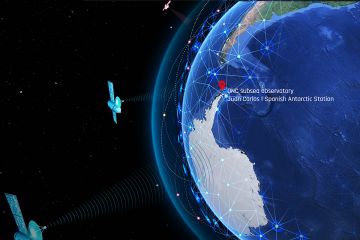Renewable energy pathways
- Jennifer Kwan

How much land will a carbon-free electricity system require?
Early in his research career, Kevin Palmer-Wilson discovered that renewable energy sources such as wind and solar could play a major role in a future carbon-free electricity system—but each method of producing energy comes with its own costs.
Palmer-Wilson, a PhD student now with the 2060 Project at the University of Victoria, witnessed first-hand public resistance to a wind farm project when he worked at a German electricity provider. Although Germany was seen as a trailblazer in renewable energy at the time, Palmer-Wilson’s project presentation nearly turned into a shouting match among rural community members.
“We need to get off fossil fuels and embrace renewables, but there is a real conflict between how people feel about their local environment and the global challenge of climate change,” recalls Palmer-Wilson of the event some five years ago. “Getting that human dimension—the public acceptance to this change—into our energy system models is vital in understanding the great challenge of climate change.”
Limiting global warming to less than 2 degrees Celsius by 2100 requires a drastic reduction of carbon emissions from electricity generation by mid-century. Wind and solar are predicted to dominate carbon emission reductions in the future, but require more space to produce energy than the more compact fossil fuels.
When factoring land and social acceptability, how viable are alternative energy sources?
Palmer-Wilson and his peers at 2060—a joint project of UVic’s Institute for Integrated Energy Systems and funder Pacific Institute for Climate Solutions—sought to factor land area into decarbonization pathways. Researchers studied fossil-fuel-rich Alberta—a globally-relevant case study where in 2017 some 87 per cent of electricity generation was by fossil fuels. They assessed the trade-offs between land-area impacts, technology alternatives such as biomass, hydro, geothermal, wind and solar, as well as the monetary costs associated with cutting carbon emissions from electricity generation.
Modelling results for 2015–2060, researchers used annual electricity consumption figures from Alberta’s utility operator and factored different scenarios that provide energy with various combinations of wind, solar, natural gas and coal in order to meet demand. With the goal of reducing emissions by 90 per cent by 2060, researchers then assessed different land-use constraints and financial costs. They found using renewables like wind and solar could require as much as 10 times more land than today, says Palmer-Wilson. In the case where no more land can be used, costs for producing electricity jumped 11 per cent.
Alternatives to renewables included carbon capture and storage, a technology that sucks CO2 emissions from exhaust and then stores it, typically underground, so emissions don’t enter the atmosphere—though scalability of this emerging technology is uncertain. Nuclear energy is another option, but opposition varies significantly across regions due to concerns about long-term storage risks of nuclear waste.
Researchers also note that renewables can’t be spread evenly across Canada because renewables have to be put in areas that are most consistently sunny or windy, or where ocean waves are most plentiful and powerful.
What path are we going to take? We can’t do nothing. We don’t have that option. We have to either mitigate climate change or we adapt. If we choose to mitigate then society has choices to make about technologies, but each comes with a cost.
—Kevin Palmer-Wilson, UVic PhD student
Edgewise: learn more
While electricity in British Columbia produces very little carbon—with 90 per cent from hydro and 6 per cent from biomass—our neighbour Alberta will need to transition away from fossil fuels in the coming decades, and either rapidly deploy renewable energy or find other ways to reduce emissions (e.g. via carbon capture and sequestration or building nuclear power plants).
Reducing carbon emissions in Alberta by 90 per cent will increase the impacted land area by a factor of 5 or 10, depending on whether the space between wind turbines is accounted for. In the latter case, the required land area for electricity production will increase from ~ 600 km² today (about the size of Alberta’s oil patch) to ~ 6,000 km² in 2060.
As a society we have to be prepared to designate increasing land area to clean electricity. While Canada has no shortage of land, residents in regions with the highest wind speeds and most sunlight may need to accept increasing energy infrastructure in their vicinity. Alternatively, we can choose to deploy higher-cost carbon capture or nuclear power to limit the expansion of land designated to electricity production.
Photos
In this story
Keywords: clean energy, climate, engineering, research, graduate research, 2060 Project, climate solutions
People: Kevin Palmer-Wilson
Publication: knowlEDGE





